Update: Duolight 250 compatibility with third-party light modifiers
Duolight 250 is a new innovative lighting solution from Promaster. It is a hybrid system that can serve as a studio strobe, a manual hot shoe flash, and a continuous light source for video recording.
Promaster Duolight 250 is well-built. It feels solid, and it has a sort of rubberized anti-slip finish that makes it nice to touch and improves the handling of it. The body design is similar to many other studio strobes, but the unit is significantly smaller than the majority of studio lights. It weighs just over a pound (18 oz. / 513 g), which is comparable to Canon Speedlite 580EX II that weighs 13.2 oz / 375 g.
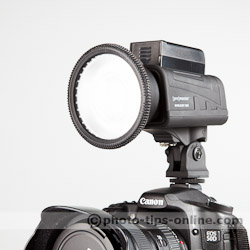 |
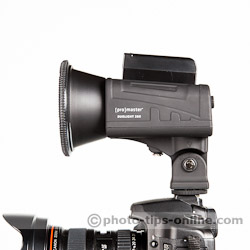 |
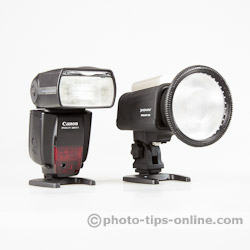 |
The Duolight 250 can be put directly onto your camera since it has a mounting foot and contacts to be triggered by the camera. While on camera, it can be operated like any other manual flash (for example,LumoPro LP160): it is not capable of any TTL metering, but it fires at a constant level that you control on the flash itself.
There are 6 LED's placed around the flash tube inside the reflector, making it great for video recording. You can use it as an on-camera light of your DSLR or have it off the camera handheld or on a light stand.
 |
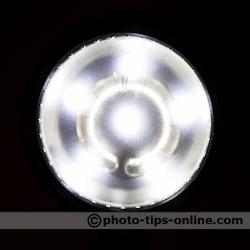 |
The LCD screen of Duolight 250 is reasonably sized (1.5" / 3.8cm). The menus, for the most part, are self-explanatory and fairly easy to use with just a selection (OK) and two navigation buttons. You should be able to figure how to control the unit just in a few minutes. The thing that you may need to look up in the instruction booklet is the triggering modes, which we'll cover below. Our only wish is for the text and symbols on the screen to be bigger. To us, they are just a bit too small, which can potentially be a challenge for some users.
The interface element we absolutely love on this Promaster unit is the power knob. The size of it feels right, and you simply rotate it to make light output adjustments, which is s lot nicer compared to +/- buttons found on many today's flashes.
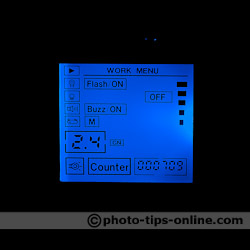 |
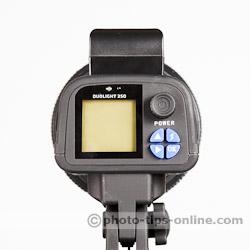 |
Like virtually any other studio strobe, Promaster Duolight 250 can be plugged into an AC wall outlet. Also, like most hot-shoe flashes (speedlights), it can be powered by 4 AA batteries. On top of that, this lighting system can work off of an optional Promaster Li-Ion Battery pack or Sony NP-550 camcorder battery. Finally, any 12V DC power source can also be used with the included car adapter. This impressive set of options gives you a lot of flexibility when shooting on location or in a studio.
We really like being able to use Li-Ion pack as it lasts longer than a set of 4 AA batteries, and it weighs about 35% less (100g/3.5oz).
AA batteries go into the special holder (included) that attaches to the Duolight the same way the the Li-Ion pack does. We are not entirely happy with the holder. Inserting and taking out batteries can be a bit cumbersome depending on the batteries you use. The holder door could be made better, as well, so it is easier to close with the batteries in place. The holder design is not bad and quite usable, but there is room for an improvement here.
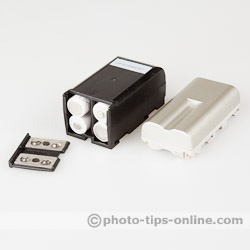 |
Promaster Duolight 250 is designed to cover a fairly wide angle of view. The two images below were taken with Duolight 250 (left) and Canon Speedlite 580EX II (right) set to 24mm zoom. You can see that the frame coverage of the Promaster unit is about 24mm. Also note that the light falloff of the Duolight unit has a nicer pattern in case you use it without a light modifier.
 |
 |
The Promaster flash is rated at 50 feet (15 m) at ISO 100, and, according to the specifications, the recycling time is up to 5 seconds. Out tests, however, showed some interesting results. If you fire the flash immediately after it signals readiness in 5 seconds at full power, the light output matches the specified Guide Number. However, if you wait for about 5 seconds more, the flash output will double (so you get a whole extra f-stop). So, the effective Guide Number is about 70 feet (22 m). This is not something that is unique to this flash. Canon flashes have similar behavior, which Canon calls Quick Flash: the unit can be fired while it is not fully charged shortening the recycling time but loosing output level. So, the way we look at this is that the recycling time is actually 2 times more than specified, but the good news is that the light output is 2 times higher than in the specs, which is really great.
To compare light output between flashes, you have to take the angle of the light spread into account. Our measurements show that Promaster Duolight 250 delivers about half the power of Canon Speedlite 580EX II set to 24mm, which means about 1 f-stop difference. This puts the Promaster unit in the same ballpark as Canon Speedlite 430EX II, Nikon Speedlight SB-700, and other mid-range flash units.
Regardless of the power source you use, the recycling time stays the same. We kind of expected Duolight 250 to recycle faster when plugged into an AC or DC outlet, but it is not the case. Also note that while the flash is relatively slow to recycle at the maximum output, it is quite fast at low levels. For example, at the minimum level, you can take a few shots with virtually no intervals.
The light output can be adjusted between what is marked as GN values of 2 and 6 (with 0.1 increments). Therefore, the range is about 3 f-stops: from the maximum (1/1) to approximately 1/8 of the full power.
With 6 LED's behind the flash tube, Promaster Duolight 250 delivers enough brightness to be used as the main or fill light for video recording.
The color temperature is specified at 5500K + or - 200K. The maximum LED light output is rated at 18 Watts. Just for the fun of it, we compared the LED brightness of Duolight 250 to Speedlite 580EX II output and found that it matches 1/64th of the full power of the Canon unit. Thus, the continuous light of Promaster Duolight 250 can even be used for some photography applications.
When shooting video, we were able to get 2 hours of continuous light from Li-Ion pack, 1 hour 20 minutes with AA Powerex 2500mAh batteries, and 1 hour 10 minutes with Eneloop 2000mAh batteries. Our original estimate was less, so these numbers were very nice to see.
When firing the Promaster lighting system at the full power, number of flashes per single charge ranges from 200 to 300 depending on the batteries.
During our battery life testing, we've been firing Promaster Duolight 250 continuously hundreds of times. There were no signs of overheating, which was not really a surprise since the flash uses a quartz tube, and the front lens has ventilation holes (there is no fan inside, though). If anything, the metal reflector got warm, but not to a degree in which you would not be able to hold or touch it.
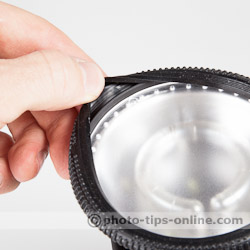 |
Duolight 250 uses the center LED (3 Watts) as a modeling light, which you can turn on and off. We didn't find it really usable for most photography applications (especially using light modifiers). In some cases, like tabletop photography, for example, it may still come in handy.
Promaster Duolight 250 features a built-in 2.4GHz radio triggering system. It comes with a hot-shoe transmitter that you can put on your camera to trigger the unit up to 98 feet (30m) away. There are 8 channels available, which you can select by using a combination of 3 switches. (Each switch can be set to ON or OFF, which gives you 8 possible combinations.)
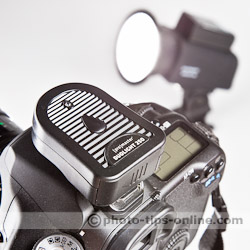 |
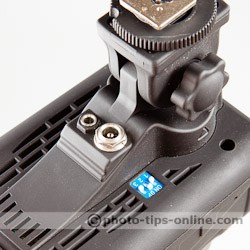 |
With Canon 50D camera body, the maximum sync speed we could get was 1/160 of a second, whereas with Canon 5D Mark II it was 1/125 (due to the slower sync speed of the camera itself). Using a Nikon D70 camera, which has a hybrid shutter and can sync up to 1/500 of a second, we were able to get consistent triggering at 1/400 of a second.
In our tests, this proprietary radio triggering system worked reliably, so we see it as a good way to trigger one or several Duolight 250 units. If, however, you want to mix other strobes or speedlights in, you would need to either use third party radio triggers or utilize optical triggering options.
When we tested Duolight 250 with PocketWizard Flex TT5, there was no problem going to the maximum 1/250 of a seconds sync speed of Canon 50D.
There are 5 flash modes you can select from: M, S1, S2, S3, and S4. M is for non-optical triggering such as via hot-shoe, sync port, or built-in radio. S1 and S2 are optical triggering modes: S1 fires the flash when another manual flash goes off, S2 works with TTL flashes because it ignores the "pre-flash" pulses. Finally, S3 and S4 are burst modes with up to 5 and 15 flashes respectively when the camera is set to continuous shooting. Obviously, to achieve the high speed bursts, the light output is significantly reduced when Duolight 250 is set to S3 or S4 mode.
Besides the radio transmitter and car adapter already mentioned, Promaster Duolight 250 comes with a light stand swivel adapter with umbrella mount, which allows you to use the unit on a light stand right out of the box.
Promaster also makes an optional accessory kit that includes a grid, softbox, and barn doors with a warming filter.
 |
Promaster Duolight 250 offers you flash and continuous light sources in one compact package. While the recycling time is on the slow side, the power level is on par with mid-range flashguns from other manufacturers. An impressive set of triggering options, including built-in optical and radio capabilities, makes this lighting system even more attractive. LED's are bright enough for many real world applications.
If you need a high-power flash for fast-paced scenarios, Duolight 250 may not be for you. If you are looking for a versatile solution that will not only allow you to take still pictures in a studio or on location but also help with your DSLR cinematography, this Promaster unit can be a good choice. While there is room for improvements, we see Promaster Duolight 250 as a step into the future of hybrid lights.